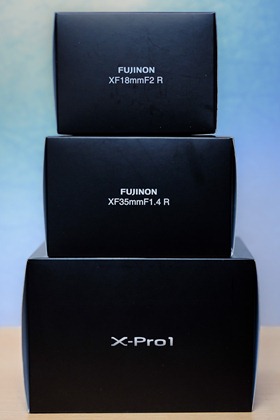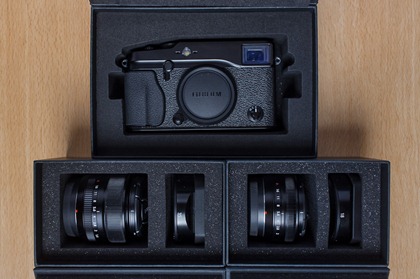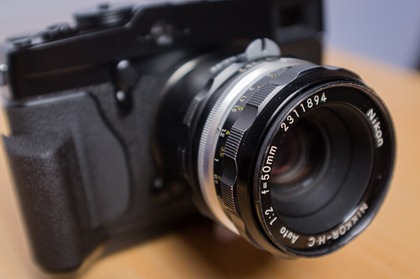Aaah! The joys of unpacking newly arrived boxes after weeks of anticipation! Opening plastic bags, slipping out exquisite pieces of craftsmanship, pondering over what-the-heck-are-these bits!
My new Fujifilm X-Pro1 camera arrived yesterday. Together with the body, I received the 35mm f/1.4 and 18mm f/2.0 lenses – a good starter’s kit corresponding to 50mm and 28mm field-of-view on full-frame systems. The 60mm f/2.4 macro lens has not arrived yet, neither has an extra NP-W126 battery (thus limiting my shooting autonomy for a while).
In this post and a series of follow-up ones, I will cover my early findings and ongoing experiences as I discover this camera. Don’t hope for technical specs, pixel-peep test frames or side-by-side comparisons to other bodies: there’s more than enough other blogs and sites for that. Stay here for a step-by-step evaluation of Fuji’s new FX system, and for hints and tips about it.
As you might know I have very much enjoyed my Fujifilm X-100 over the past year. An intriguing device with original technology, excellent image quality but also eh… its own ‘identity’. Those who persisted however, willing to somewhat adjust their ways for optimal results, have been charmed by its unique qualities. A number of firmware updates have made the X-100 much closer to what its engineers must have intended at the start. So expect that form time to time I will compare the X-Pro1 to the X-100.
First encounters
Just as with the X-100, Fuji brings us nicely styled and sleek but also functional packaging. Everything that should be there is indeed included with the body and lenses. This time, even the lens hoods, and quite original ones too.
The body feels nice and solid, lighter than many seem to have expected. But isn’t the reduced weight one of the famed advantages of mirrorless systems? The lenses are compact and light as well, but I don’t see any reason to doubt about their quality and robustness.
What at first sight looks like a generous piece of microfiber cloths, packed with each lens, turns out to be a handy lens pouch. The carrying strap is made from leather and more discrete than the X-100 one. Good enough to start with.
Time to put a lens on the body. If you’re a long-time Nikon user like me, you will suddenly find yourself in a universe where all things look reversed: the unlocking button seems oddly placed at the ‘wrong’ side, and lens alignment and twist direction are different too. Something to get accustomed to.
Throw in a battery (that of course was already charging in the background) and a memory card. As with the X-100, go for the fastest card you can obtain and afford: it does make a significant difference especially if you are/will be shooting RAW. I use 16GB SanDisk Extreme Pro SDHC cards rated at 95MB/s, and these make me happy as a clam.
Now let’s look through the viewfinder, a hybrid one of course, that’s one of the features to want this camera for in the first place. I don’t have the impression (like others) that the X-Pro1 offers a smaller image compared to the X-100. I do believe however that the eye point is different: wearing my glasses (as usual) I find it harder to see all four corners at the same time.
But unfortunately, there’s more… Fuji has left out a built-in diopter adjustment, and that makes it impossible for me to get a sharp image across the viewfinder. Even worse, I use progressive glasses, and I can only see near-sharp through their bottom half. That means awkward head positioning and neck contortions.
It is possible exchange the ‘neutral’ ocular by a diopter lens matching your eyesight. Such 19mm round diopters have been used before on Zeiss/Cosina cameras and Nikon F-bodies. They are not easy to find, and (as I found out) mostly available on order only. I will have to wait a few more weeks for my +2 relief!
I also got the optional hand grip, as seen in the above picture. It doesn’t add a lot of weight or bulk, but makes the hold just that bit more comfortable. Having not that large hands, I am not sure I really need it, or even will end up using it most of the time. Only a lot of shooting practice will tell. But hey, I went for it anyway: you know it hurts less when extras are added to the initial order!
More accessories
The absence of a reflex mirror box makes it possible to move the elements of a ‘native’ mirrorless lens a lot closer to the sensor. That, in turn, opens the way to use adapter rings – essentially metal tubes with a different lens mount at each side – for attaching ‘foreign’ DSLR lenses at their original imaging distance.
I purchased a Chinese Kipon adapter for using Nikon F-mount lenses on Fuji FX-mount bodies. No mechanical links or electrical connections are present, so both focus and aperture control remain entirely manual, and must be set from the lens. Pre-AI, AI, AI-S, AF and AF-D lenses will do; G-type lenses (including all those for the DX crop format) will be stuck at their smallest aperture setting (highest f-number) and thus be pretty useless.
Kipon has announced a second generation device with an added control ring to (approximately) set the aperture from the adapter itself. That will make G-lenses work as well, and yes, my copy is already on its way from Hong Kong.
I have a collection of older and recent F-lenses, and some of these should be fun to use on the X-Pro1: fast ones like a 50mm f/1.4 and 85mm f/2.8, a 16mm fisheye (why did I sell the 10.5mm DX when I went FX?), a 90mm macro… I even kept a copy of the 28-200G, a small and lightweight do-it-all. Think compact 42-300mm sneak-in-the-bag travel lens?
The few ones I quickly slapped onto the adapter all worked well, at least mechanically. Below is the X-Pro1 with the Kipon adapter and a 1976 Nikon 50mm f/2.0, the very first SLR lens I bought from my own money!
And now for something completely relevant…
All of the above are mere impressions from my first 24 hours with the camera. Yes, of course I have initial opinions on image quality, AF speed, MF usability, aperture blade chatter… but all are way too early to be meaningful, as I have hardly made a decent shot so far (I don’t have a dog nor a black cat, no brick wall either, you see?).
The good news: tomorrow I will have the opportunity to take my X-Precious out all day long. A Belgiumdigital Shooting Day will take us to both an urban/industrial site and a nature preservation area. The X-100 will tag along (I fear that a single X-Pro1 battery will not take me through the day…).
Stay tuned for real images and more observations!
P.S. A small note to the title: Black Box Revelation is a Belgian garage rock band with a fast growing international reputation.
Gear notes: Fujifilm X-Pro1, 35mm f/1.4 – Fujifilm X100
Click on the image(s) to see a larger version





3 comments:
Hi René! Nice review! Looking forward to see your pictures.
I am eagerly awaiting my set I ordered from a Lux shop online. Should arrive this week.
One question: how did you measure your diopter? I have also adaptive glasses (age!) and would appreciate your input!
Thanks and lots of pleasure with the new toy!
Bruno
Bruno,
Safest way is to go by your optometrist once you have the camera, and ask for their help.
Optical viewfinders like the X-Pro1 one usually have a built-in correction of -1.0D and have the image 'set' at a viewing distance of 1 to 2m. So whatever correction you need for that distance, adjusted for the built-in diopter value, is what you need.
I was lucky to have a set of +1D/+2D/+4D close-up filters lying around. I just looked through these into the viewfinder (wearing my glasses of course) to determine my optimal diopter choice ;)
Thanks René!
Bruno. (www.couck.net)
Post a Comment